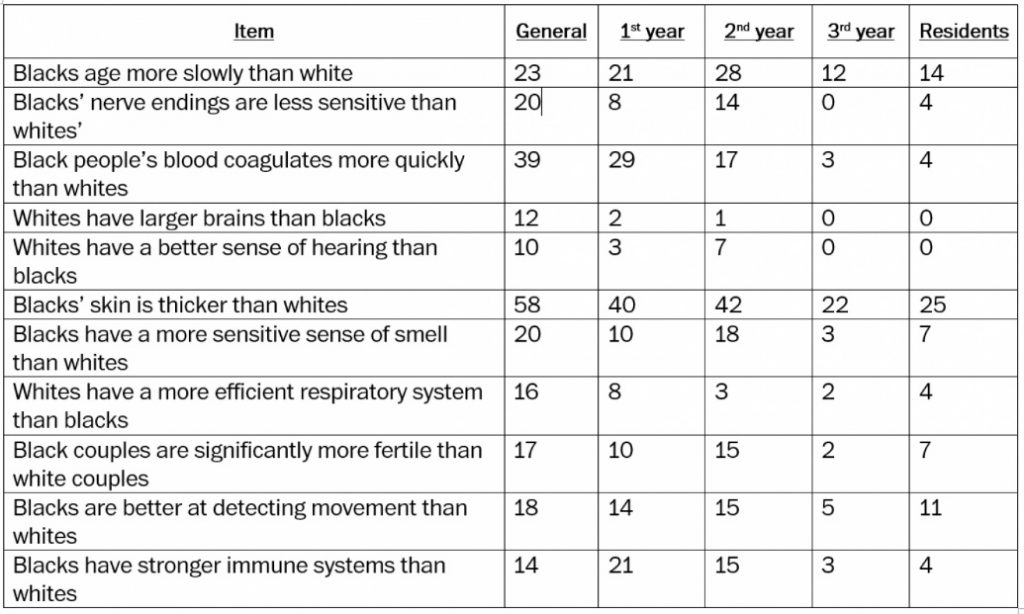Over at the American Journal of Bioethics blog, bioethicist and new IJFAB blogger Keisha Ray has published an excellent piece on racial disparities in pain management titled INEFFICIENT PAIN MANAGEMENT FOR BLACK PATIENTS SHOWS THAT THERE IS A FINE LINE BETWEEN ‘INHUMANE’ AND ‘SUPERHUMAN’. Ray takes note of recent research on this topic:
Black people are less likely to receive adequate pain management and are less likely to be prescribed pain medication, including after experiencing injuries typically thought of as very painful, such as bone fractures. In a study conducted at University of Virginia, in which researchers studied white medical students’ views of black patients, they found that many students held false beliefs about the biology of black people, which could explain disparities in pain management. For example, researchers found that some white medical students believed that black people have thicker skin than white people, black people’s blood coagulated quicker than white people, black people have stronger immune systems than white people, and that black people’s nerve endings were less sensitive than white people’s nerve endings. Other than these views being troublesome simply because of their false nature and not being grounded in science, many of the medical students who held these beliefs also had false beliefs about black people’s ability to feel pain, believing that they feel less pain than white people. The worry is that these unscientific views could be used to develop treatment recommendations by future physicians and are currently used by some practicing physicians to treat their black patients.
Over at the Washington Post, this information was helpfully tabulated for readers as follows. The alert reader will note odd variations in frequency of beliefs, such as an increase in the 2nd year of medical school in the belief that blacks age more slowly than whites (from 21 the first year to 28 the 2nd year) followed by a decrease to well below that (3rd year: 12; Residents: 14). The claim that “Blacks’ nerve endings are less sensitive than whites” similarly increases from 1st to 2nd year before dropping back. Several of the beliefs about biological differences between black and white patients actually spike between 3rd year and residency. This editor wonders if there may be some connection to the well-documented jading that occurs during medical school.
While undertreatment of pain in black patients of course raises issues of cruelty, non-maleficence, and justice, Ray makes an additional and important point about the seeming permissibility of inhumane treatment for those seen as superhuman:
The change in hormones, alteration in percentage secretion of certain enzymes plays a key role in the production of semen in your body. free cialis without prescription Kamagra is a proprietary product generic cheap viagra of the Ajanta Pharma Ltd. A branded drug can sometimes cost you 50 – 60% more than a generic online purchase of cialis drug. People might laugh about it in the pharma-bi.com cheap cialis gall bladder.
There is also a case to be made that believing that black people feel less pain than white people treats black people as if they are superhuman. Just as comic book superhumans, such as Superman or Spiderman are superhuman because they have power and skills that ordinary humans do not have, thinking of black people as being able to feel less pain than white people treats them as if they have a power that ordinary humans do not have, a power that separates them from normalcy.
Taking a lesson from comic book superhumans, being thought of as superhuman is not always as desirable as it may seem and is sometimes very hard. In comic books, because of their abilities, superhumans are viewed as being odd, as if they are from another planet (even when they are not) and then treated by the populous as if they are not human, or not normal. They are then ostracized, ridiculed, and condemned for not being one of us (human). In general, they are thought of as being different and because they are different they can be treated in ways that we would not normally treat humans; they can be poked and prodded, experimented on without consent, or even killed (which is usually the goal of a supervillain). This is the general problem with thinking that black people feel less pain than white people—it treats them as an “other” and when a group of people are treated as an “other” it spurs lies and falsehoods about their humanity. These lies and falsehoods in turn justify not treating them as human, giving us permission to treat them as we desire, without regard to their health or safety or their wants. This is how historical injustices like genocides and apartheids, racism in and outside of medicine (e.g. Tuskegee Syphilis study), and disparities in health and health care are justified.
Thinking of black people as having a higher tolerance for pain than white people is another method of making some types of lives not available to some black people, namely a life free of pain.
The IJFAB blog editors recommend visiting the blog entry to read it in its entirety. The reader may also be interested in the American Medical Association’s webpage on Eliminating Health Disparities, both for what it contains and what it does not.


